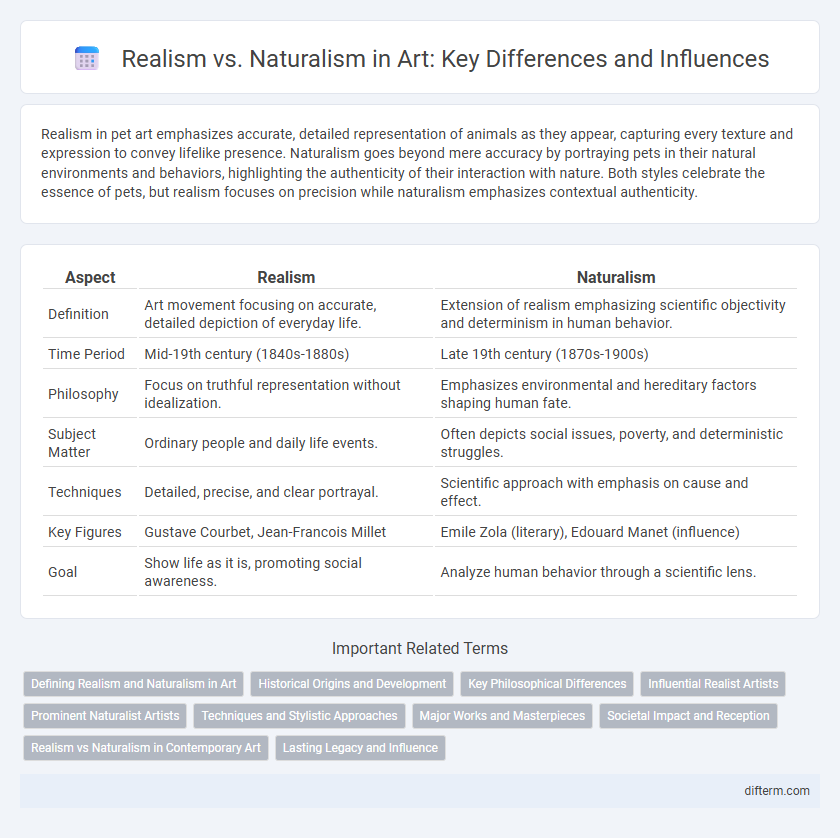Realism in pet art emphasizes accurate, detailed representation of animals as they appear, capturing every texture and expression to convey lifelike presence. Naturalism goes beyond mere accuracy by portraying pets in their natural environments and behaviors, highlighting the authenticity of their interaction with nature. Both styles celebrate the essence of pets, but realism focuses on precision while naturalism emphasizes contextual authenticity.
Table of Comparison
| Aspect | Realism | Naturalism |
|---|---|---|
| Definition | Art movement focusing on accurate, detailed depiction of everyday life. | Extension of realism emphasizing scientific objectivity and determinism in human behavior. |
| Time Period | Mid-19th century (1840s-1880s) | Late 19th century (1870s-1900s) |
| Philosophy | Focus on truthful representation without idealization. | Emphasizes environmental and hereditary factors shaping human fate. |
| Subject Matter | Ordinary people and daily life events. | Often depicts social issues, poverty, and deterministic struggles. |
| Techniques | Detailed, precise, and clear portrayal. | Scientific approach with emphasis on cause and effect. |
| Key Figures | Gustave Courbet, Jean-Francois Millet | Emile Zola (literary), Edouard Manet (influence) |
| Goal | Show life as it is, promoting social awareness. | Analyze human behavior through a scientific lens. |
Defining Realism and Naturalism in Art
Realism in art emphasizes accurate, detailed, and unembellished depiction of nature or contemporary life, capturing ordinary subjects with a focus on everyday scenes and people. Naturalism extends realism by incorporating a scientific approach, portraying subjects with an emphasis on environmental and hereditary influences, often highlighting the darker or more deterministic aspects of life. Both movements reject romantic idealization, but naturalism delves deeper into the causes and conditions shaping human behavior and social realities.
Historical Origins and Development
Realism emerged in mid-19th century France as a reaction against Romanticism, emphasizing accurate, unembellished depictions of everyday life and working-class subjects. Naturalism developed shortly after, influenced by scientific approaches and determinism, portraying humans as products of their environment and heredity with a more detailed, often harsher perspective. Both movements shaped modern art by challenging idealized representations, but realism centers on observable reality, while naturalism integrates social conditions and biological factors into its narrative.
Key Philosophical Differences
Realism emphasizes accurate, detailed depictions of everyday life, focusing on objective reality without idealization, while naturalism extends this by incorporating a deterministic view shaped by environmental and hereditary factors. Realist artists portray subjects with precision, reflecting social truths, whereas naturalists delve into the influence of biology and sociology on human behavior. The key philosophical difference lies in realism's commitment to objective representation versus naturalism's exploration of the forces governing human existence.
Influential Realist Artists
Influential realist artists such as Gustave Courbet, Jean-Francois Millet, and Honore Daumier revolutionized 19th-century art by emphasizing accurate, unidealized depictions of everyday life and social conditions. Their works challenged romanticized interpretations by focusing on ordinary subjects and raw human experiences, laying the groundwork for modern visual storytelling. Realism's dedication to truthful representation contrasts with naturalism's broader focus on environment and heredity, highlighting the nuanced differences between the two art movements.
Prominent Naturalist Artists
Prominent naturalist artists such as Gustave Courbet, Jean-Francois Millet, and Jules Bastien-Lepage emphasized accurate, detailed depictions of everyday life and nature, rejecting the idealized forms of realism. Their works highlight ordinary subjects with a focus on lighting, texture, and environmental context to capture the essence of natural settings. Naturalism in art provides an empirical approach, contrasting with the more interpretive and often social critique-driven elements of realism.
Techniques and Stylistic Approaches
Realism employs precise brushwork and detailed observation to depict everyday subjects with unembellished accuracy, emphasizing social realities and authentic human experiences. Naturalism extends this approach by incorporating scientific principles and a focus on environmental influence, using meticulous shading and color modulation to enhance lifelike representation. Both techniques prioritize truthful portrayal, but naturalism accentuates the deterministic relationship between individuals and their surroundings through a more immersive and atmospheric style.
Major Works and Masterpieces
Realism's major works, such as Gustave Courbet's "The Stone Breakers" and Jean-Francois Millet's "The Gleaners," emphasize accurate depictions of everyday life and social issues, showcasing unidealized human experiences. Naturalism, represented by artists like Jules Bastien-Lepage in "Haymaking" and Emile Friant in "The Beheading," extends realism with detailed observation and scientific objectivity to portray nature and rural life authentically. These masterpieces highlight distinct approaches in 19th-century art, where realism underscores societal truths while naturalism focuses on environmental and hereditary influences on subjects.
Societal Impact and Reception
Realism and naturalism in art profoundly influenced societal perceptions by highlighting everyday life and socio-economic conditions with unembellished accuracy. Realism garnered appreciation for its truthful representation of ordinary people, promoting empathy and social awareness during the 19th century. Naturalism, intensifying this approach with scientific objectivity and determinism, sparked debate on human environment interactions, shaping public discourse on social issues and cultural values.
Realism vs Naturalism in Contemporary Art
Realism in contemporary art emphasizes accurate, detailed, and unembellished depiction of subjects, capturing everyday life with social and political commentary. Naturalism in contemporary art extends this focus by incorporating a scientific observation of the natural world, often highlighting environmental and biological elements with an objective, empirical approach. Both movements diverge in methodology: Realism prioritizes subjective human experience, while Naturalism seeks to represent life through detached, precise documentation.
Lasting Legacy and Influence
Realism's lasting legacy lies in its commitment to depicting everyday life with precise detail and social commentary, influencing modern art movements and documentary photography. Naturalism extended this impact by emphasizing environmental and hereditary factors on human behavior, shaping literature, theater, and visual arts with a scientific approach to observation. Both movements continue to inspire contemporary artists who pursue authenticity and nuanced representation of the human experience.
realism vs naturalism Infographic

 difterm.com
difterm.com